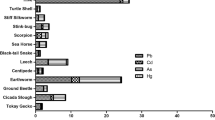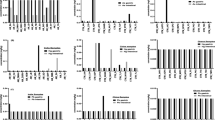Abstract
Few studies reported the extent of heavy metal accumulation in traditional Chinese medicines (TCMs). Currently, oral bioaccessibility of lead (Pb), cadmium (Cd), arsenic (As), mercury (Hg), and copper (Cu) present in traditional animal medicines was investigated with physiologically based extraction test–extracted in vitro model. We are the first to develop a health risk assessment strategy by combinational analysis of bioaccessible heavy metal levels to calculate target hazard quotient (THQ), target hazard index (THI) and cancer risk (CR), which has capacity to evaluate the heavy metal associated heath risk of traditional animal medicines. To precisely acquire a realistic risk assessment, questionnaire data was adopted to measure the frequency and duration of the exposure to traditional animal medicines, and the safety factor was highlighted as well. Our data revealed that the bioaccessibility of Hg was the lowest among the five heavy metals. After the adjustment with the bioaccessibility of each heavy metal to target hazard index (THI) values, excitingly, the results manifested that the consumption of traditional animal medicines might not exert an unacceptable health risk in a broad community. In addition, the CR values of As and Pb indicated that the risk of developing cancers was quite lower than their acceptable levels in the clinic.


Similar content being viewed by others
Data availability
All data are fully available without restriction.
Abbreviations
- TCMs:
-
Traditional Chinese Medicines
- PBET:
-
the physiologically based extraction test
- CR:
-
lifetime cancer risk
- CSF:
-
cancer slope factor
- CDI:
-
chronic daily intake
- ICP-MS:
-
inductively coupled plasma mass spectrometry
- PPRC:
-
Pharmacopoeia of the People’s Republic of China
- THQ:
-
target hazard quotient
- THI:
-
target hazard index
References
Amoozadeh E, Malek M, Rashidinejad R, Nabavi S, Karbassi M, Ghayoumi R, Ghorbanzadeh-Zafarani G, Salehi H, Sures B (2014) Marine organisms as heavy metal bioindicators in the Persian Gulf and the Gulf of Oman. Environ Sci Pollut Res 21:2386–2395
Appleton JD, Cave MR, Wragg J (2012) Modelling lead bioaccessibility in urban topsoils based on data from Glasgow, London, Northampton and Swansea, UK. Environ Pollut 171:265–272
Brzezicha-Cirocka J, Grembecka M, Szefer P (2016) Monitoring of essential and heavy metals in green tea from different geographical origins. Environ Monit Assess 188:183–194
Cheng JL, Zhang XH, Tang ZW, Yang YF, Nie ZQ, Huang QF (2017) Concentrations and human health implications of heavy metals in market foods from a Chinese coal-mining city. Environ Toxicol Pharmacol 50:37–44
Cui GL, Li LY, Tan J, Zhang Y, Niu J (2018) Assay and safety evaluation of heavy metals in Citrus medica var. sarcodactylis from different areas of Sichuan Province. Chin J Trop Crop 39(12):2491–2498
Dieter MP, Matthews HB, Jeffcoat RA, Moseman RF (1993) Comparison of lead bioavailability in F344 rats fed lead acetate, lead-oxide, leadsulfide, or lead ore concentrate from Skagway, Alaska. J Toxicol Environ Health 39:79–93
Freeman GB, Johnson JD, Killinger JM, Liao SC, Feder PI, Davis AO, Ruby MV, Chaney RL, Lovre SC, Bergstrom PD (1992) Relativebioavailability of lead from mining waste soil in rats. Fundam Appl Toxicol 19:388–398
Ghaleno OR, Sayadi M, Rezaei M (2015) Potential ecological risk assessment of heavy metals in sediments of water reservoir case study: Chah Nimeh of Sistan. Proc Int Acad Ecol Environ Sci 5(4):89–96
Gu YG, Huang HH, Lin Q (2016) Concentrations and human health implications of heavy metals in wild aquatic organisms captured from the core area of Daya Bay’s Fishery Resource Reserve, South China Sea. Environ Toxicol Pharmacol 45:90–94
Gu YG, Lin Q, Huang HH, Wang LG, Ning JJ, Du FY (2017) Heavy metals in fish tissues/stomach contents in four marine wild commercially valuable fish species from the western continental shelf of South China Sea. Mar Pollut Bull 114:1125–1129
Gu YG, Ning JJ, Ke CL, Huang HH (2018) Bioaccessibility and human health implications of heavy metals in different trophic level marine organisms: a case study of the South China Sea. Ecotoxicol Environ Saf 163:551–557
IRIS (2012) Integrated risk information system. Available athttps://www.epa.gov/research/integrated-risk-information-system-iris-current-assessments-and-recentdevelopments-0
Järup L (2003) Hazards of heavy metal contamination. Br Med Bull 68:167–182
Karadas C, Kara D (2011) In vitro gastro-intestinal method for the assessment of heavy metal bioavailability in contaminated soils. Environ Sci Pollut Res 18:620–628
Khan S, Cao Q, Zheng YM, Huang YZ, Zhu YG (2008) Health risks of heavy metals in contaminated soil and food crops irrigated with wastewater in Beijing, China. Environ Pollut 152(3):686–692
Koch I, McPherson K, Smith P, Easton L, Doe KG, Reimer KJ (2007) Arsenic bioaccessibility and speciation in clams and seaweed from a contaminated marine environment. Mar Pollut Bull 54:586–594
Li YY, Wang HB, Wang HJ, Yin F, Yang XY, Hu YJ (2014) Heavy metal pollution in vegetables grown in the vicinity of a multimetal mining area in Gejiu, China: total concentrations, speciation analysis, and health risk. Environ Sci Pollut Res 21(21):12569–12582
Liao W, Gao TH, Lin MS, Zhang BX, Fu CM (2018) Correlation between heavy metal elements in Curcuma herbs and their genuineness. Chin Tradit Herb Drugs 49(12):2833–2839
Liu SY, Tian SH, Li K, Wang LQ, Liang T (2018) Heavy metal bioaccessibility and health risks in the contaminated soil of an abandoned, small-scale lead and zinc mine. Environ Sci Pollut Res 25(15):15044–15056
Lu GY, Ke CH, Zhu AJ, Wang WX (2017) Oyster-based national mapping of trace metals pollution in the Chinese coastal waters. Environ Pollut 224:658–669
Madrid F, Biasioli M, Ajmone-Marsan F (2008) Availability and bioaccessibility of metals in fine particles of some urban soils. Arch Environ Contam Toxicol 55:21–32
Mahmood A, Malik RN (2013) Human health risk assessment of heavy metals via consumption of contaminated vegetables collected from different irrigation sources in Lahore, Pakistan. Arab J Chem 7(1):91–99
Nemati S, Mosaferi M, Ostadrahimi A, Mohammadi A (2014) Arsenic intake through consumed rice in Iran: markets role or government responsibility. Environ Health Perspect 4(2):180
Oomen AG, Hack A, Minekus M, Zeijdner E, Cornelis C, Schoeters G, Verstraete W, van de Wiele T, Wragg J, Rompelberg CJM, Sips AJAM, van Wijnen JH (2002) Comparison of five in vitro digestion models to study the bioaccessibility of soil contaminants. Environ Sci Technol 36:3326–3334
Pelfrêne A, Waterlot C, Mazzuca M, Nisse C, Cuny D, Richard A, Denys S, Heyman C, Roussel H, Bidar G, Douay F (2012) Bioaccessibility of trace elements as affected by soil parameters in smelter-contaminated agricultural soils: a statistical modeling approach. Environ Pollut 160:130–138
Pelfrêne A, Waterlot C, Douay F (2013) Influence of land use on human bioaccessibility of metals in smelter-impacted soils. Environ Pollut 178:80–88
Peng Q, Nunes LM, Greenfield BK, Dang F, Zhong H (2016) Are Chinese consumers at risk due to exposure to metals in crayfish? A bioaccessibility-adjusted probabilistic risk assessment. Environ Int 88:261–268
Poggio L, Vrščaj B, Schulin R, Hepperle E, Ajmone Marsan F (2009) Metals pollution and human bioaccessibility of topsoils in Grugliasco (Italy). Environ Pollut 157(2):680–689
Qin X (2008) Bilirubin would be the indispensable component for some of the most important therapeutic effects of Calculus Bovis (Niuhuang). Chin Med J 121:480
Recatala L, Sanchez J, Arbelo C, Sacristan D (2010) Testing the validity of a Cd soil quality standard in representative Mediterranean agricultural soils under an accumulator crop. Sci Total Environ 409:9–18
Ruby MV, Davis A, Schoof R, Eberle S, Sellstone CM (1996) Estimation of lead and arsenic bioavailability using a physiologically based extraction test. Environ Sci Technol 30:422–430
Schroder JL, Basta NT, Si J, Casteel SW, Evans T, Payton M (2003) In vitro gastrointestinal method to estimate relative bioavailable cadmium in contaminated soil. Environ Sci Technol 37:1365–1370
Sirot V, Guérin T, Volatier JL, Leblanc JC (2009) Dietary exposure and biomarkers of arsenic in consumers of fish and shellfish from France. Sci Total Environ 407:1875–1885
Sridhara CN, Kamala CT, Raj DSS (2008) Assessing risk of heavy metals from consuming food grown on sewage irrigated soils and food chain transfer. Ecotoxicol Environ Saf 69(3):513–524
Subotić S, Spasić S, Višnjić-Jeftić Ž, Hegediš A, Krpo-Ćetković J, Mićković B, Skorić S, Lenhardt M (2013) Heavy metal and trace element bioaccumulation in target tissues of four edible fish species from the Danube River (Serbia). Ecotoxicol Environ Saf 98:196–202
Takahashi K, Azuma Y, Shimada K, Saito T, Kawase M, Schaffer SW (2010) Quality and safety issues related to traditional animal medicine: role of taurine. J Biomed Sci 17(Suppl 1):1–9
Tang WZ, Zhang WQ, Zhao Y, Zhang H, Shan BQ (2017) Basin-scale comprehensive assessment of cadmium pollution, risk, and toxicity in riverine sediments of the Haihe Basin in north China. Ecol Indic 81:295–301
The Pharmacopoeia Commission of the People's Republic of China (2015). (2015). Beijing: Pharmacopoeia of the People’s Republic of China, Chinese Medical Science and Technology Publishers
United States Environmental Protection Agency (USEPA) (2007) Framework for Metals Risk Assessment. https://www.epa.gov/risk/framework-metals-risk-assessment
Vicente-Martorell JJ, Galindo-Riaño MD, García-Vargas M, Granado-Castro MD (2009) Bioavailability of heavy metals monitoring water, sediments and fish species from a polluted estuary. J Hazard Mater 162:823–836
Vieira C, Morais S, Ramos S, Delerue-Matos C, Oliveira MBPP (2011) Mercury, cadmium, lead and arsenic levels in three pelagic fish species from the Atlantic Ocean: intra- and inter-specific variability and human health risks for consumption. Food Chem Toxicol 49:923–932
Wang YR, Wang RM, Fan LY, Chen TT, Bai YH, Yu QR, Ying L (2017) Assessment of multiple exposure to chemical elements and health risks among residents near Huodehong lead-zinc mining area in Yunnan, Southwest China. Chemosphere 174:613–627
Wang XN, Gu YG, Wang ZH, Ke CL, Mo MS (2018) Biological risk assessment of heavy metals in sediments and health risk assessment in bivalve mollusks from Kaozhouyang Bay, South China. Mar Pollut Bull 133:312–319
Wragg J, Cave M, Basta N, Brandon E, Casteel S, Denys S, Gron C, Oomen A, Reimer K, Tack K, van de Wiele T (2011) An inter-laboratory trial of the unified BARGE bioaccessibility method forarsenic, cadmium and lead in soil. Sci Total Environ 409:4016–4030
Zang XD, Huang HSY, Zhuang ZL, Chen RS, Xie ZY, Xu C, Mo XM (2018) The association between serum copper concentrations and cardiovascular disease risk factors in children and adolescents in NHANES. Environ Sci Pollut Res Int 25:16951–16958
Zhou J, Liang J, Hu YM, Zhang WT, Liu HL, You LY, Zhang WH, Gao M, Zhou J (2018) Exposure risk of local residents to copper near the largest flash copper smelter in China. Sci Total Environ 630:453–461
Zuo TT, Li YL, He HZ, Jin HY, Zhang L, Sun L, Gao F, Wang Q, Shen YJ, Ma SC, He LC (2019) Refined assessment of heavy metal-associated health risk due to the consumption of traditional animal medicines in human. Environ Monit Assess 191:171–182
Acknowledgments
We would like to express our gratitude to Dr. Yuanjun Shen from the University of Pittsburgh for the useful suggestions.
Funding
This study was supported by the National Major Scientific and Technological Special Project for “Significant New Drugs Development” (2018ZX09735006) and Project for Medicine and Medical Instruments Review and Approval System Reform (ZG2016-1).
Author information
Authors and Affiliations
Contributions
SCM and HYJ designed the study. TTZ, HRQ, and LZ conducted the experiments. TTZ analyzed the data. TTZ wrote the manuscript. HZH, SCM, LS, FG, QW, and FYL revised the manuscript. KZY authenticated the samples. All authors read and approved the final manuscript.
Corresponding authors
Ethics declarations
Ethics approval and consent to participate
Not applicable.
Consent for publication
Not applicable.
Competing interests
The authors declare that they have no competing interests.
Additional information
Responsible editor: Philippe Garrigues
Publisher’s note
Springer Nature remains neutral with regard to jurisdictional claims in published maps and institutional affiliations.
Rights and permissions
About this article
Cite this article
Zuo, TT., Qu, HR., Jin, HY. et al. Innovative health risk assessments of heavy metals based on bioaccessibility due to the consumption of traditional animal medicines. Environ Sci Pollut Res 27, 22593–22603 (2020). https://doi.org/10.1007/s11356-020-08769-2
Received:
Accepted:
Published:
Issue Date:
DOI: https://doi.org/10.1007/s11356-020-08769-2




